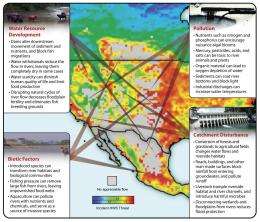Report casts world's rivers in 'crisis state'

(PhysOrg.com) -- The world's rivers, the single largest renewable water resource for humans and a crucible of aquatic biodiversity, are in a crisis of ominous proportions, according to a new global analysis.
The report, published today (Sept. 30) in the journal Nature, is the first to simultaneously account for the effects of such things as pollution, dam building, agricultural runoff, the conversion of wetlands and the introduction of exotic species on the health of the world's rivers.
The resulting portrait of the global riverine environment, according to the scientists who conducted the analysis, is grim. It reveals that nearly 80 percent of the world's human population lives in areas where river waters are highly threatened posing a major threat to human water security and resulting in aquatic environments where thousands of species of plants and animals are at risk of extinction.
"Rivers around the world really are in a crisis state," says Peter B. McIntyre, a senior author of the new study and a professor of zoology at the University of Wisconsin-Madison's Center for Limnology.
The Nature report was authored by an international team co-led by Charles J. Vörösmarty of the City University of New York, an expert on global water resources, and McIntyre, an expert on freshwater biodiversity.
Examining the influence of numerous types of threats to water quality and aquatic life across all of the world's river systems, the study is the first to explicitly assess both human water security and biodiversity in parallel. Fresh water is widely regarded as the world's most essential natural resource, underpinning human life and economic development as well as the existence of countless organisms ranging from microscopic life to fish, amphibians, birds and terrestrial animals of all kinds.
Over many millennia, humans have exerted an increasingly pervasive influence on fresh water resources. Rivers, in particular, have attracted humans and have been altered through damming, irrigation and other agricultural and engineering practices since the advent of civilization. In recent times, chemical pollution, burgeoning human populations, and the accidental as well as purposeful global redistribution of plants, fish, and other animal species have had far-reaching effects on rivers and their aquatic inhabitants.
"Flowing rivers represent the largest single renewable water resource for humans," notes Vörösmarty. "What we've discovered is that when you map out these many sources of threat, you see a fully global syndrome of river degradation."
What jumps out, say McIntyre and Vörösmarty, is that rivers in different parts of the world are subject to similar types of stresses, such things as agricultural intensification, industrial development, river habitat modification and other factors. Compounding the problem is that some of the negative influences on rivers arrive in indirect ways. Mercury pollution, for example, is a byproduct of electricity generation at coal-fired power plants and pollutes surface water via the atmosphere.
"We find a real stew of chemicals flowing through our waterways," explains Vörösmarty, noting that the study represents a state-of-the-art summary, yet was unable to account for such things as threats from mining, the growing number of pharmaceuticals found in surface water and the synergistic effects of all the stresses affecting rivers.
"And what we're doing is treating the symptoms of a larger problem," Vörösmarty explains. "We know it is far more cost effective to protect these water systems in the first place. So the current emphasis on treating the symptoms rather than the underlying causes makes little sense from a water security standpoint or a biodiversity standpoint, or for that matter an economic standpoint."
Among the startling conclusions of the study is that rivers in the developed world, including much of the United States and Western Europe, are under severe threat despite decades of attention to pollution control and investments in environmental protection. Huge investments in water technology and treatment reduce threats to humans, but mainly in developed nations, and leave biodiversity in both developed and developing countries under high levels of threat, according to the new report.
"What made our jaws drop is that some of the highest threat levels in the world are in the United States and Europe," says McIntyre, who began work on the project as a Smith Fellow at the University of Michigan. "Americans tend to think water pollution problems are pretty well under control, but we still face enormous challenges."
The hard lessons learned by the developed world, says McIntyre, can help governments and planners in other parts of the world avoid making the same mistakes and experiment with new strategies for promoting water security and protecting biodiversity. Instead of investing billions of dollars in expensive remediation technologies, strategies such as protecting watersheds, for example, can reduce the costs of drinking water treatment, preserve floodplains for flood protection and enhance rural livelihoods.
Rivers of the world least at risk are those where human populations are smallest. Rivers in arctic regions and relatively inaccessible areas of the tropics appear to be in the best health.
The analysis used data sets on river stressors around the world. Built into state-of-the-art computer models, the data yield maps that integrate all of the individual stressors into aggregate indices of threat. The same strategy and data, say Vörösmarty and McIntyre, can be used by governments worldwide to assess river health and improve approaches to protecting human and biodiversity interests.
"We've created a systematic framework to look at the human water security and biodiversity domains on an equal footing," Vörösmarty says. "We can now begin presenting different options to decision makers to create environmental blueprints for the future."
Provided by University of Wisconsin-Madison

















